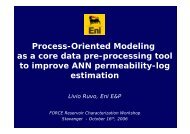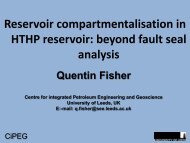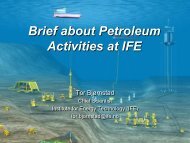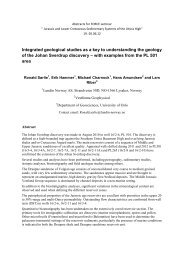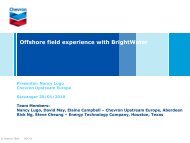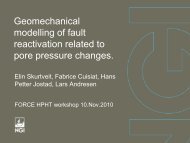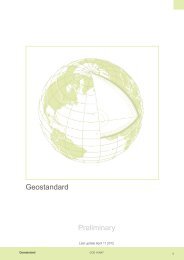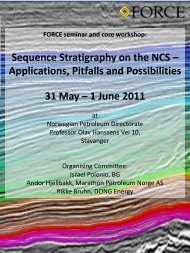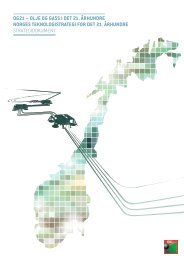Use of SBED as a tool for permeability modelling in ... - Force
Use of SBED as a tool for permeability modelling in ... - Force
Use of SBED as a tool for permeability modelling in ... - Force
You also want an ePaper? Increase the reach of your titles
YUMPU automatically turns print PDFs into web optimized ePapers that Google loves.
<strong>Use</strong> <strong>of</strong> <strong>SBED</strong> <strong>as</strong> a <strong>tool</strong> <strong>for</strong> <strong>permeability</strong> <strong>modell<strong>in</strong>g</strong> <strong>in</strong> heterolithic<br />
tidal reservoirs: a test study from the Njord Field<br />
<strong>SBED</strong> meet<strong>in</strong>g October 16 th 2006<br />
Mike Young
Outl<strong>in</strong>e<br />
• Introduction<br />
- Motivation beh<strong>in</strong>d the study<br />
- <strong>Use</strong> <strong>of</strong> <strong>SBED</strong> <strong>in</strong> Hydro<br />
• Tilje Formation, Njord Field - <strong>SBED</strong> test study<br />
- Challenge <strong>of</strong> <strong>modell<strong>in</strong>g</strong> the Tilje Fm.<br />
- Why <strong>SBED</strong>?<br />
- Data set used <strong>in</strong> the study<br />
- Methodology/workflow<br />
- Results<br />
• Summary/comments on the <strong>SBED</strong> approach
Introduction<br />
• Motivation<br />
- Theoretically <strong>SBED</strong> is a good concept<br />
- Hydro h<strong>as</strong> supported <strong>SBED</strong> <strong>for</strong> some time<br />
- Test out <strong>in</strong> practice … can the <strong>tool</strong> be implemented <strong>in</strong> the BU’s ?<br />
• Good test c<strong>as</strong>e: Heterolithic tidal facies <strong>of</strong> the Tilje Fm., Njord Field<br />
- Difficult to characterize us<strong>in</strong>g “conventional” petrophysical/property <strong>modell<strong>in</strong>g</strong><br />
- <strong>SBED</strong>/TBED designed to model tidal heterogeneity<br />
• Internal use <strong>in</strong> Hydro<br />
- Limited to a research activity<br />
- Low priority activity<br />
- At present, it is difficult and time consum<strong>in</strong>g (expensive) to get results !<br />
- Uncerta<strong>in</strong>ty <strong>in</strong> <strong>SBED</strong> is a key issue that is poorly addressed
Challenge <strong>of</strong> <strong>modell<strong>in</strong>g</strong> the Tilje Fm., Njord<br />
Th<strong>in</strong> <strong>in</strong>tercalations <strong>of</strong> mudstone and<br />
sandstone layers will have a strong <strong>in</strong>fluence<br />
on the flow properties!
Why use <strong>SBED</strong>?<br />
Core plug data: Tilje 3A Formation<br />
Question:<br />
Can we derive petrophysical properties from<br />
these data (core plugs) that are representative at<br />
the grid-cell scale <strong>of</strong> a reservoir model ?<br />
Problems:<br />
Kv and Kh are NOT well characterized by core<br />
plugs or wirel<strong>in</strong>e data.<br />
Permeability data me<strong>as</strong>ured from core plugs that<br />
have a sample volume below the REV will be<br />
unrepresentative.<br />
There<strong>for</strong>e we see extreme variability <strong>of</strong> plug<br />
permeabilities (Kv, Kh) even <strong>in</strong>side small vertical<br />
<strong>in</strong>tervals.<br />
Answer:<br />
No! But us<strong>in</strong>g <strong>SBED</strong> to model the heterogeneity<br />
at a more suitable volume (REV) and us<strong>in</strong>g flowb<strong>as</strong>ed<br />
upscal<strong>in</strong>g to determ<strong>in</strong>e properties could<br />
be a more realistic solution…<br />
Th<strong>in</strong> <strong>in</strong>tercalations <strong>of</strong> mudstone and<br />
sandstone layers will have a strong <strong>in</strong>fluence<br />
on the flow properties!
Data set<br />
6407/7-4 Tilje 3A<br />
• Cored well 6407/7-4 (Njord E<strong>as</strong>t Flank)<br />
- <strong>Use</strong>d <strong>as</strong> a test c<strong>as</strong>e<br />
- Thick Tilje 3A<br />
- Good petrophysical data set<br />
• Core plug & m<strong>in</strong>i-perm. data<br />
• Wirel<strong>in</strong>e and synthetic poro-perm data<br />
Tilje 3A<br />
50 m<br />
• Tidal heterolithics (Tilje 3A)<br />
- Vertically aggraded tidal flat deposits<br />
- Composed <strong>of</strong> tidal bundles<br />
- Wavy, fl<strong>as</strong>er and lenticular beds
Core plug poro. – perm. data (Tilje 3A, Njord)<br />
Large scatter <strong>in</strong> Kv and Kh !<br />
Correlation = 0,67
<strong>SBED</strong> Methodology/Workflow used<br />
• Generate bedd<strong>in</strong>g-scale sub-models/<strong>SBED</strong> templates<br />
• Petrophysical data analysis (core plugs/m<strong>in</strong>i-perm. data)<br />
• Populate sub-models with petrophysical values<br />
• Calibrate <strong>SBED</strong> petrophysical <strong>in</strong>put values<br />
• Mov<strong>in</strong>g w<strong>in</strong>dow upscal<strong>in</strong>g to generate the <strong>SBED</strong> output results
Generate <strong>SBED</strong> sub-models<br />
6407/7- 4 Tilje 3A<br />
• Split up core <strong>in</strong>to <strong>in</strong>tervals modelled with<br />
specific <strong>SBED</strong> templates<br />
- Different sub-models needed to capture variations <strong>in</strong><br />
the sand:shale ratio (NTG)<br />
- Intervals <strong>of</strong> approx. 5% sand:shale (<strong>SBED</strong> NTG)<br />
- i.e. 10%, 15%, 20% ….. 100% sand<br />
• Key parameters<br />
- Sand to shale ratio (NTG <strong>in</strong> <strong>SBED</strong>)<br />
- Geometry, thickness variation and frequency <strong>of</strong> the<br />
mud layers<br />
• Mean & STD <strong>for</strong> porosity and <strong>permeability</strong><br />
- Values needed <strong>for</strong> each lithotype <strong>in</strong> each submodel<br />
50 m<br />
Model size 30x30x30 cm<br />
26 different <strong>SBED</strong> models needed to capture variation <strong>in</strong><br />
sand:shale (NTG) and sedimentary architecture
Sand:shale ratio key <strong>in</strong> these tidal facies<br />
Key <strong>modell<strong>in</strong>g</strong> parameter - it will have a strong <strong>in</strong>fluence on vertical and horizontal <strong>permeability</strong>.<br />
Predictable relationship between sand:shale ratio and geometry/cont<strong>in</strong>uity <strong>of</strong> the bed<strong>for</strong>ms.<br />
Fl<strong>as</strong>er – Lenticular bedd<strong>in</strong>g transition<br />
<strong>SBED</strong> submodels<br />
95% sand<br />
50% sand<br />
Ca. 50m<br />
10% sand<br />
After Re<strong>in</strong>eck & Wunderlich (1968)
Petrophysical <strong>in</strong>put data<br />
• Porosity and <strong>permeability</strong> <strong>for</strong> each <strong>of</strong><br />
the lithological components <strong>of</strong> the<br />
model (i.e. ebb sand, flood sand, mud)<br />
• Mean and STD values<br />
2<br />
• Variogram value<br />
• Poro-perm correlation (e.g. 0,67)<br />
1
Petrophysical data analysis<br />
• We need to f<strong>in</strong>d <strong>permeability</strong>/porosity values <strong>for</strong> each lithotype (sand 1 & 2, mud…)<br />
• Not an e<strong>as</strong>y t<strong>as</strong>k …<br />
- There is typically a bi<strong>as</strong>ed data b<strong>as</strong>e sampl<strong>in</strong>g at the wrong volume (core plugs)<br />
- M<strong>in</strong>i-permeameter data are better, but rarely taken <strong>as</strong> standard …<br />
- Especially difficult to get <strong>permeability</strong> values <strong>for</strong> the mud layers<br />
• Key steps: Filter out “bi<strong>as</strong>ed plugs” that conta<strong>in</strong> multiple lithotypes<br />
Asses porosity and <strong>permeability</strong> distributions <strong>for</strong> the entire dat<strong>as</strong>et and <strong>for</strong> subsets:<br />
e.g. specific <strong>in</strong>tervals <strong>of</strong> NTG, depth <strong>in</strong>tervals …<br />
<strong>Use</strong> these results <strong>as</strong> a start<strong>in</strong>g po<strong>in</strong>t !<br />
M<strong>in</strong>i-perm<br />
Plug data<br />
Few data po<strong>in</strong>ts below 50%<br />
sand:shale ratio (essentially <strong>SBED</strong> submodel divisions)
Porosity (sand)<br />
Shapes <strong>of</strong> the distributions<br />
sketched to highlight their nature<br />
95-100<br />
Mean = 0,23<br />
STD = 0,03<br />
0-65<br />
Mean = 0,14<br />
STD = 0,04<br />
70-80<br />
Mean = 0,18<br />
STD = 0,04<br />
85-90<br />
Mean = 0,20<br />
STD = 0,03<br />
• Porosity distribution <strong>for</strong> the entire data set (sand layers)<br />
- Need to make sense <strong>of</strong> this and break it down <strong>in</strong>to subsets<br />
• Porosity distribution <strong>for</strong> specific <strong>in</strong>tervals <strong>of</strong> NTG (sand:shale ratios)<br />
- Divisions b<strong>as</strong>ed on visual <strong>in</strong>spection <strong>of</strong> the core and determ<strong>in</strong>ation <strong>of</strong> <strong>in</strong>tervals with “similar” sand type<br />
- B<strong>as</strong>ed on splitt<strong>in</strong>g up the data set <strong>in</strong>to various different <strong>in</strong>tervals <strong>of</strong> NTG<br />
- B<strong>as</strong>ed on this data it is possible to determ<strong>in</strong>e mean and STD values<br />
- May not be simple Gaussian distributions !
Permeability (sand)<br />
• Distributions <strong>for</strong> the NTG <strong>in</strong>tervals<br />
- Core plug data and m<strong>in</strong>i-perm<br />
- Complex distributions, commonly with at le<strong>as</strong>t<br />
two sand types <strong>in</strong> each <strong>of</strong> the NTG <strong>in</strong>tervals !<br />
• Permeability distribution <strong>for</strong> the entire<br />
data set<br />
Shapes <strong>of</strong> the distributions<br />
sketched to highlight their nature<br />
• Core plug data are bi<strong>as</strong>ed, so m<strong>in</strong>i-perm<br />
data are better at captur<strong>in</strong>g values <strong>for</strong><br />
<strong>in</strong>dividual sand layers<br />
- However, m<strong>in</strong>i-perm data show bi<strong>as</strong> towards<br />
the higher perm. layers !<br />
Shapes <strong>of</strong> the distributions<br />
sketched to highlight their nature
Effect <strong>of</strong> vary<strong>in</strong>g <strong>in</strong>put data (petrophysics)<br />
• Results from upscal<strong>in</strong>g <strong>of</strong> all realisations <strong>of</strong> <strong>SBED</strong> submodels <strong>for</strong> the Tilje 3A, 6407/7-4<br />
• 5 different model versions - same geometric <strong>in</strong>put, but different petrophysical <strong>in</strong>put<br />
- i.e. the variation is related almost exclusively to the petrophysics<br />
• Key observation: The petrophysical <strong>in</strong>put data have a significant impact on the results!<br />
Variation <strong>in</strong><br />
Kh between<br />
the different<br />
models<br />
Variation <strong>in</strong><br />
Kv between<br />
the different<br />
models
Calibration <strong>of</strong> the <strong>SBED</strong> model <strong>in</strong>put<br />
• An important step is to calibrate the petrophysical values <strong>in</strong> the models<br />
- Key question: Have we captured the true variation <strong>in</strong> petrophysical values ?<br />
- Answer: Almost certa<strong>in</strong>ly not at the first attempt !<br />
• Need to generate ”pseudo” core plugs from the <strong>SBED</strong> models<br />
- Extract volumes from the models that are the same <strong>as</strong> the actual core plugs<br />
- These need to be upscaled (flow b<strong>as</strong>ed, fixed boundary) and compared to the actual<br />
core plug data<br />
- Compare the porosity-<strong>permeability</strong> cross-plot<br />
- Compare the porosity and <strong>permeability</strong> frequency distributions<br />
Vertical plug<br />
10 cm<br />
10 cm<br />
2.5 cm<br />
Horizontal plug<br />
2.5 cm<br />
90% Sand model populated with <strong>permeability</strong>
• Input petrophysics should be adjusted until an acceptable match is obta<strong>in</strong>ed<br />
between pseudo and real core plugs<br />
• It is likely that several iterations <strong>of</strong> this process will be needed !<br />
0 - 65<br />
95 - 100<br />
Frequency %<br />
25,00<br />
20,00<br />
15,00<br />
10,00<br />
Core plugs<br />
Pseudo plugs (<strong>SBED</strong> model)<br />
Kh<br />
Frequency %<br />
45,00<br />
40,00<br />
35,00<br />
30,00<br />
25,00<br />
20,00<br />
15,00<br />
Core plugs<br />
Pseudo plugs (<strong>SBED</strong> model)<br />
5,00<br />
10,00<br />
5,00<br />
0,00<br />
0,01 0,03 0,05 0,07 0,09 0,11 0,13 0,15 0,17 0,19 0,21 0,23 0,25 0,27 0,29<br />
Porosity B<strong>in</strong>s<br />
0,00<br />
0,01 0,03 0,05 0,07 0,09 0,11 0,13 0,15 0,17 0,19 0,21 0,23 0,25 0,27 0,29<br />
Porosity B<strong>in</strong>s<br />
70-80<br />
85-90<br />
30<br />
25<br />
Core plugs<br />
Pseudo plugs (<strong>SBED</strong> model)<br />
35<br />
30<br />
Core plugs<br />
Pseudo plugs (<strong>SBED</strong> model)<br />
Frequency %<br />
20<br />
15<br />
10<br />
Frequency %<br />
25<br />
20<br />
15<br />
10<br />
5<br />
5<br />
0<br />
0,01 0,03 0,05 0,07 0,09 0,11 0,13 0,15 0,17 0,19 0,21 0,23 0,25 0,27 0,29<br />
Porosity B<strong>in</strong>s<br />
0<br />
0,01 0,03 0,05 0,07 0,09 0,11 0,13 0,15 0,17 0,19 0,21 0,23 0,25 0,27 0,29<br />
Porosity B<strong>in</strong>s<br />
<strong>SBED</strong> pseudo plugs and the actual plugs have the same sample<br />
volume. We could expect a similar scatter <strong>in</strong> both data sets !
Results<br />
• Several different options here …<br />
• Chosen to build a “stacked model” <strong>for</strong> the<br />
cored <strong>in</strong>terval – i.e. a direct representation <strong>of</strong><br />
the core<br />
• Mov<strong>in</strong>g w<strong>in</strong>dow upscal<strong>in</strong>g enables upscaled<br />
results at a log scale (e.g. every 12.5 cm) <strong>for</strong><br />
Kh, Kv, Porosity<br />
• Upscal<strong>in</strong>g method is dynamic (flow-b<strong>as</strong>ed)<br />
method with fixed boundary conditions<br />
• Why log scale ?<br />
- Consistent with wirel<strong>in</strong>e data (same scale)<br />
- Can be used together with wirel<strong>in</strong>e data to predict<br />
properties (esp. Kh, Kv) <strong>in</strong> non-cored wells<br />
• The s<strong>of</strong>tware “Facimage” w<strong>as</strong> used to<br />
generate ”electr<strong>of</strong>acies” and predict<br />
<strong>permeability</strong> <strong>in</strong> non-cored wells/<strong>in</strong>tervals<br />
<strong>SBED</strong> results used <strong>as</strong> “tra<strong>in</strong><strong>in</strong>g” data
Us<strong>in</strong>g cluster<strong>in</strong>g and nearest neighbour <strong>in</strong>dex (NNI) the “electr<strong>of</strong>acies” and <strong>SBED</strong>-<strong>permeability</strong> (def<strong>in</strong>ed <strong>for</strong> cored<br />
<strong>in</strong>tervals) can be propagated to non-cored well <strong>in</strong>tervals. Us<strong>in</strong>g the <strong>in</strong>put from <strong>SBED</strong> this is a more geologically<br />
b<strong>as</strong>ed and accurate method <strong>for</strong> predict<strong>in</strong>g <strong>permeability</strong> and def<strong>in</strong><strong>in</strong>g “flow facies” that will be taken <strong>in</strong>to RMS.
Summary<br />
• In tidal heterolithic facies (e.g. Tilje Fm.) it is difficult to determ<strong>in</strong>e<br />
representative <strong>permeability</strong> values us<strong>in</strong>g conventional core plugs<br />
• <strong>SBED</strong> method w<strong>as</strong> used to generate log-scale <strong>permeability</strong> b<strong>as</strong>ed on<br />
process b<strong>as</strong>ed model<strong>in</strong>g <strong>of</strong> small-scale geology (bedd<strong>in</strong>g scale)<br />
• Mov<strong>in</strong>g w<strong>in</strong>dow upscall<strong>in</strong>g enabled Kh and Kv values to be generated at<br />
the log scale (ca. 12,5 cm), consistent with other wirel<strong>in</strong>e data<br />
• Kh and Kv logs from <strong>SBED</strong> can be used <strong>as</strong> “tra<strong>in</strong><strong>in</strong>g” data <strong>for</strong><br />
<strong>permeability</strong> and facies prediction <strong>in</strong> non-cored wells<br />
- E.g. Us<strong>in</strong>g the NNI method <strong>in</strong> Paradigm Facimage<br />
• <strong>SBED</strong>/Facimage can provide a more realistic (Kh and Kv) and consistent<br />
data <strong>in</strong>put to the geo-model (RMS)<br />
- All <strong>in</strong>put data with a similar sample volume<br />
- Bedd<strong>in</strong>g scale, but not necessarily representative at the grid block !<br />
- Additional <strong>modell<strong>in</strong>g</strong> and upscal<strong>in</strong>g step may be necessary
Comments on the use <strong>of</strong> <strong>SBED</strong><br />
• Calibrat<strong>in</strong>g the <strong>in</strong>put data is an important/critical step<br />
- Otherwise it is difficult to determ<strong>in</strong>e whether the results can be trusted<br />
- Potentially a large range <strong>in</strong> uncerta<strong>in</strong>ty<br />
- <strong>SBED</strong> could be equally <strong>as</strong> uncerta<strong>in</strong> <strong>as</strong> conventional plug-b<strong>as</strong>ed methods<br />
- Manual and very time consum<strong>in</strong>g, but critical step <strong>in</strong> the workflow !!<br />
• <strong>SBED</strong> projects are labour <strong>in</strong>tensive and thus expensive<br />
- Possibly hundreds <strong>of</strong> man hours <strong>for</strong> a relatively small project !<br />
- Especially with the manual calibration technique<br />
• <strong>SBED</strong> is a specialist <strong>tool</strong> and still somewhat immature<br />
- Not recommended <strong>for</strong> wider use <strong>in</strong> Hydro BU’s yet !



